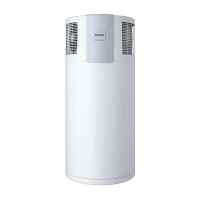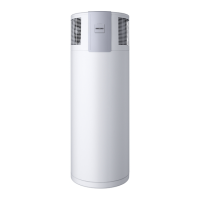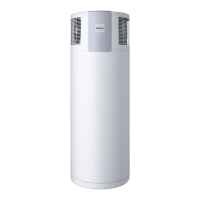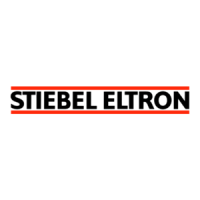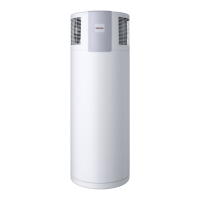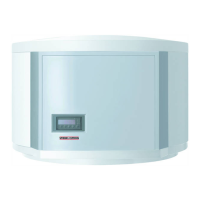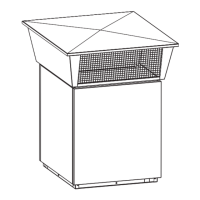OPERATION
Appliance description
www.stiebel-eltron.com WWK 223-303 electronic | 5
ENGLISH
2.2 General safety instructions
The appliance should only be operated once it is fully installed
and all safety equipment has been fitted.
!
WARNING Injury
The appliance may be used by children over 8 years of
age and persons with reduced physical, sensory or men-
tal capabilities or a lack of experience and expertise,
provided that they are supervised or they have been
instructed on how to use the appliance safely and have
understood the potential risks. Children must never play
with the appliance. Cleaning and user maintenance must
not be carried out by children without supervision.
WARNING Electrocution
Contact with live components presents a threat to life.
Damage to the insulation or to individual components
may result in a threat to life.
f If there is damage to the insulation, switch off the
power supply and arrange a repair.
All work on the electrical installation must be carried
out by a qualified contractor.
WARNING Burns
The water in the DHW cylinder can be heated to temper-
atures in excess of 60°C. There is a risk of scalding at
outlet temperatures in excess of 43°C.
f Ensure you do not come into contact with the water
when discharged.
WARNING Burns
Touching hot components can lead to burns.
When working on hot components, always wear protec-
tive working clothing and safety gloves.
The pipework connected to the DHW outlet of the appli-
ance can reach temperatures in excess of 60°C.
WARNING Burns
The appliance is filled with refrigerant at the factory.
In the event of refrigerant escaping due to a leak, avoid
coming into contact with the refrigerant or inhaling the
released vapours. Ventilate the rooms affected.
WARNING Electrocution
Never operate the appliance when the casing is open or
without a cover.
!
CAUTION Injury
Never place any objects on top of the appliance. If objects
are left on the appliance, noise emissions may increase
due to resulting vibrations, and the objects could fall
and cause injury.
!
Material losses
If you disconnect the appliance from the power supply, it
is no longer protected against frost or corrosion.
f Never interrupt the power supply to the appliance.
If voltage is supplied to the impressed current anode
and the PCB separately, the appliance remains protected
against corrosion.
!
Material losses
Never cover the appliance. Covering the air intake or air
discharge leads to a reduced air supply. If the air supply
is restricted, the operational reliability of the appliance
cannot be guaranteed.
!
Material losses
Only operate the appliance when the DHW cylinder has
been filled. If the DHW cylinder is empty, safety equip-
ment switches off the appliance.
!
Material losses
Heating liquids other than potable water is not permitted.
!
Material losses
Keep the appliance installation site free from air contami-
nated with oil or salt (chloride) and corrosive or explosive
substances. Avoid heavy contamination of the installation
site with dust, hairspray or substances containing chlo-
rine or ammonia.
!
Material losses
Ensure that the appliance, the water pipes and the safety
valve are free from any risk of frost.
!
Material losses
Operating the appliance outside the application limits
(see "Specification/ Data table") is not permitted. The
appliance may be damaged if operated continuously out-
side the application limits.
Note
The appliance is pressurised. During the heat-up process,
expansion water will drip from the safety valve.
f If water continues to drip when heating is complet-
ed, please inform your qualified contractor.
2.3 Test symbols
See type plate on the appliance.
3. Appliance description
This appliance enables DHW to be supplied efficiently to several
draw-off points using renewable energy. The appliance extracts
heat from the ambient air. This heat is used to heat up the water
in the DHW cylinder with added electric power. The amount of
electrical energy and time required to heat up the DHW depend
on the temperature of the air drawn in. When the air intake tem-
perature drops, the heat pump's heating output is reduced and
the heat-up time is extended.
In the case of indoor installation, the air inside the installation
room can be cooled by 1°C to 3°C due to heat extraction. The
appliance also extracts moisture from the air, which turns into
condensate. The condensate is removed from the appliance via
the condensate drain.
External signal transmitters can be integrated via the built-in con-
tact input, e.g. a photovoltaic system to make use of solar power
generated on site.
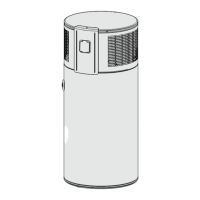
